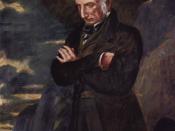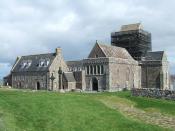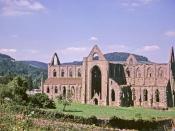How TINTERN ABBEY evolves from beginning to end is in a truly reflective state upon
the five years that had passed since he had last visited the ruins of the abbey. The ruin
of the abbey, perhaps can be compared to the aging of man and the inevitably of aging,
however, the abbey still stands as does natutre and its eternal splendor. The poem
starts immediately with an adjective, "rolling" referring to the waters coming down from
the mountain springs which do not disturb the "murmur" of the river: "These waters,
rolling from their mountain-springs/With a sweet murmur." (3-4). The gentle, quietness
of the river Wye which Wordworth adored and the visual picture of the rolling of the
water from the mountain springs give the reader a feeling of serenity.
The tone of the poem is calm and mediative and Wordsworth describes the "landscape"
and compares it to the "quiet" of the sky: "The landscape with the quiet of the sky."(8).
The plots of land surrounding his dear land are lovingly described with the color, green.
He gives the woods an almost human personality with the use of the verb, "run"in line l7;
"Of sportive wood run wild; these paastoral farms" (l7). The life of the woods surrounding
the Abbey are almost given human like qualities in order to show how man is and must
be part of nature.
In the third stanza of the poem his tone changes and he almost becomes angry at the
fact that he had left the abbey and returned to a life which had left him unfullfilled;
"How often has my spirit turned to thee!"(58). In lines 89-92, "For I have learned /To
look on nature, not as in the hour/Of thoughtless youth, but hearing oftentimes/The still,
sad music of humanity,"(89-92) his tone becomes...


